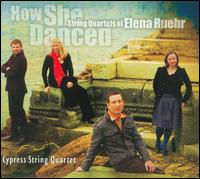Elena Ruehr
Sequenza 21
Posted by Phil Muse

String Quartets of Elena Ruehr
Performed by the Cypress String Quartet
Cypress Performing Arts Association "HOW SHE DANCED"
I was enchanted with this, my first acquaintance with the music of American composer Elena Ruehr, and I think you will be, too. A strong, engaging personality suffuses her music. She was born and spent her early years in Michigan's Upper Peninsula, an area of much natural beauty that is said to have the most beautiful fall colors in America. Her music reflects a variety of traditional and world influences in addition to her formal education under mentors William Bolcom, Milton Babbitt and Vincent Persichetti. The daughter of a mathematician, she admits to a fondness for solving intellectual puzzles such as 12-tone rows, but she decided at an early stage in her career to leave the complicated stuff beneath the surface of what people hear, incorporating it into the musical form (For the record, Mozart did much the same thing).
As a result, her music, of which we get a good sampling here from String Quartets 1, 3 and 4, written between 1991 and 2005, is both accessible and challenging. We sometimes forget, in analyzing the art of the string quartet, how sensually beautiful the sound of these four strings can be. Ruehr reminds us. Her art consists in large part of long melodies, long intonations and exhalations, gorgeously swelling tones and smartly struck pizzicati. The members of the Cypress Quartet – Cecily Ward and Tom Stone, violins; Ethan Filner, viola; and Jennifer Kloetzel, cello – attest to the challenges they encountered in performing these works in an interview with radio host Bill McGlaughlin, excerpted in the program notes. They speak from experience of the 17-bar melody with a canon in 3 parts, with all four players playing fragments of it here and there, in the slow movement of Quartet No. 3. In this movement, entitled "The Abbey" and taking its inspiration from the style of 12th Century Abbess Hildegard von Bingen, the chant-like melody is supported by a catchy rhythm derived from it.The trick, which the Cypresses bring out with deceptive ease, is to make the music sound as simple and natural as possible.
Quartet No. 4 was written in 2005 on commission from the Cypress Quartet as part of its "Call & Response" series. In this instance, the task was to look at relationships between Mozart's "Dissonant" Quartet in C, K465 and Beethoven's Op. 59/3 in the same key. The intriguing opening movement draws in the listener. The second movement (Aria: Andante) plays like a long, hauntingly beautiful improvisation. The third is marked Minuet: Grazioso, though I wouldn't advise trying to dance to its intricate patterns. The final movement has a pronounced motor rhythm and striking pizzicati.
Quartet No. 3 looks to ancient and traditional music for inspiration. Besides the afore-mentioned "Abbey" movement, Ruehr evokes the music of South American pan flutes and West African drums in the movements entitled "Clay Flute" and "Bell Call," respectively, while "How she Danced" was inspired by the sight of her young daughter dancing in the kitchen. Ruehr disclaims writing that tune, citing a traditional source, and for sure it has the distinct echo of folk fiddling.
So, surprisingly, does the second movement of Quartet No. 1, which Ruehr says was intended as a tribute to Bach and the Well-Tempered Clavier. It starts off reverently enough, but by the end the rhythm has taken on an existence of its own. The opening movement, a tribute, to the 13th Century composer Perotin entitled "Patterns," evokes both the medieval composer's sequences and his gently rocking lilt. The Third movement, "Let's Sit Beneath the Stars," is achingly beautiful and sad, like a lullaby. The last, Estampie, is inspired by the old French "stamping dance" of that name. It builds in excitement, helped by the vigorous phrasing and sensational pizzicati of the Cypress Quartet members. The ending is typically abrupt for Elena Ruehr. Having said what she had to say (which is a lot), she stops.